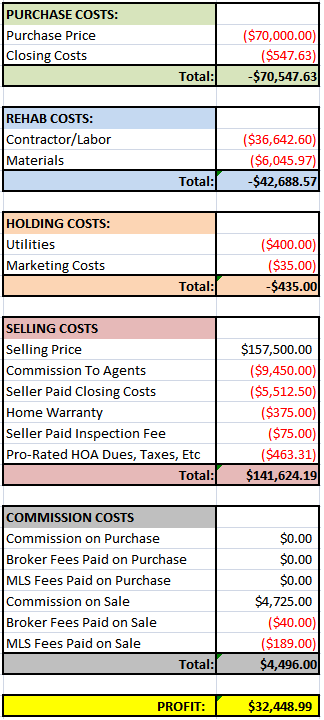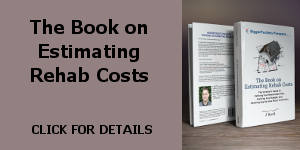We closed on the sale of The Rot House earlier this week for a great profit and ROI (see details below)…
The project went relatively smoothly, and except for a few things that were missed during the rehab (that we had to take care of after the buyer’s inspection), there were no major surprises and no major issues. During the renovation, we met a neighbor who is getting ready to move and is looking to sell her house, so hopefully we’ll get another deal on this street in the near future.
Anyway, not much to say on this one, so here is the full final analysis…
Timelines
Here are the key timeline milestones:
- Purchase Offer Date: 6/2/2012
- Purchase Closing Date: 9/28/2012
- Rehab Completion Date: 11/23/12
- Sale Listing Date: 11/20/2012
- First Sale Contract Date: 12/10/2012
- Final Sale Contract Date: 12/10/2012
- Sale Closing Date:1/17/2013
Financials
Here is the breakdown of financials for this project:

The utilities cost is just a guess, as I haven’t gotten final utility bills yet.
Final Statistics
Here are just some of the final statistics that I’ve been tracking for all my projects, and that summarize the success/failure of each project pretty well:
- From Offer to Purchase Time: 118 Days
- Rehab Time: 53 Days
- Selling Days on Market: 20 Days
- Selling Close Time: 38 Days
- Total Hold Time (Close to Close): 111 Days
- Total Profit: 32,448.99$
- Return on Investment (ROI): 28.55%
- Annualized ROI: 93.87%




Congratulations once again.
Your hold time seems high compared to your other deals seems like. Was it because you listed during the holidays or was buyer activity less than usual?
Do you track the cost of rehab on a per/sft basis? I like doing that to give me an idea of how easy/complex a rehab was.
Well done!
Hey Luis,
The extra long hold time was a combination of the higher-price point in this area, the house being a bit older than we normally do and the holidays, which weren’t as busy this year as previous years.
This project came in around $21/sf. Our typical full interior cosmetic rehab is about $10/sf. Add basic exterior repairs and painting and it comes to about $12/sf. Add a new roof/gutters and it ups to about $14-15/sf. The extra $6-7/sf we spent on this one accounted for repairing a bunch of termite damage, finishing part of the basement, replacing the HVAC system and rebuilding the front porch.
Interesting. That is a fairly expensive rehab then, at least for Atlanta standards at this price point. My most complex rehab has been $26/sft and my average is $19/sft.
Luis –
We’ve had several houses that we’ve had to gut that we spent $30/sf here in Atlanta. The first Milwaukee project was nearly $60/sf. And House #43 (The Tear-Down House) will likely be $60-70/sf to tear down and rebuild. That said, our rehabs are all over the place in terms of costs.
J Scott
Looks like a great deal. What are the tax implications when flipping houses? I see where you made a profit of $32,448.99. What is the tax rate on that profit?
thank you…
Hey Steve,
Flipping is considered ordinary business income (no different than if I were buying and reselling shoes or cars or pencils), so it’s taxed at whatever the marginal tax rate of the owner is. For example, let’s say you earn enough to be taxed in the 25% bracket, you’ll pay 25% federal taxes…if you earn enough to be taxed in the 33% bracket, you’ll pay 33% in taxes. You’ll also be subject to self-employment tax, just like any other self-employed business income.
I should have included this question in 1 of my other posts but do you guys go mainly after foreclosures, short sales or homes that have just been on the market for a certain amount of days??
Blair
I have been following your blog for a bit now. Great info! One question I had is that by having the IRS treat your rehab profits as business income (not investment), could you just buy a few properties at the end of the year to increase total business costs (inventory) and minimize taxes owed on overall profit?
Hey Tim –
Anything that is purchased with the intent to resell (inventory) isn’t allowed to be deducted in the year it was purchased. You can only deduct the purchase and rehab costs in the year the inventory is sold. For example, we purchased Houses #39, 41, 42 and 43 in late 2012 (and won’t be selling them until this year), so we can’t use any of those purchases as deductions in 2012. We’ll only be able to deduct those expenses in 2013, when we sell the properties. That’s just how inventory products are handled for tax purposes.